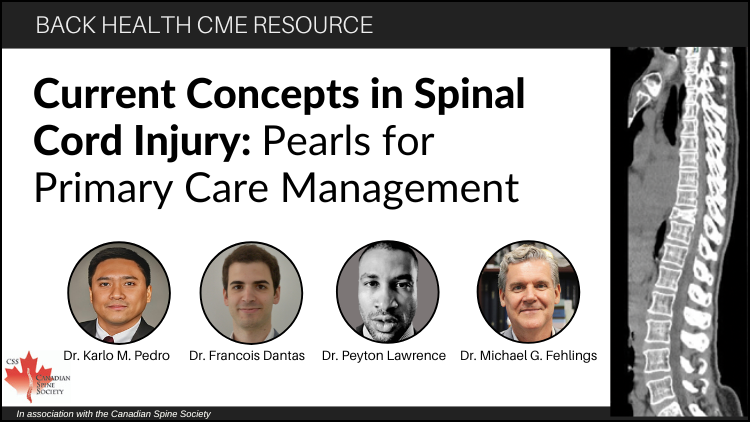Current Concepts in Spinal Cord Injury: Pearls for Primary Care Management



Dr. Michael Gordon recently retired after a fulfilling career as a geriatrician that spanned 56 years, 44 of which he spent working at the Baycrest Center in Toronto. He is Emeritus Professor of Medicine at the University of Toronto. Dr. Gordon is a recognized ethicist and a thought leader on all topics of care of the elderly and end-of-life decisions. Currently, Dr. Gordon provides part-time professional medical consulting mainly in the domain of cognition and memory loss.

Alykhan Abdulla, BSC, MD, LMCC, CCFPC, DipSportMed CASEM, FCFCP, CTH (ISTM), CCPE, Masters Cert Phys Leader, ICD.D is the Medical Director of The Kingsway Health Centre, The Kingsway Travel Clinic, and The Kingsway Cosmetic Clinic. He is also the Assistant Professor at the University of Ottawa Faculty of Medicine and Academic Clinical Professor at the University of Ottawa Faculty of Nursing. In addition he is the Director of UOttawa Undergraduate Medical Education Leadership Development Curricula. Dr. Abdulla is the Editor in Chief Journal of Current Clinical Care Sports Medicine section. He is the Board Director Bruyere Continuing Care, ESO-OHT Primary Care Table, Ontario Medical Foundation, College of Family Physicians of Canada, 700 Sussex Drive Board (OCLCC 713), The Rideau Club Finance & Audit and Past Chair Section of General and Family Practice Ontario Medical Association.

Moiz Lakhani, BHSc graduate from McMaster University and current medical student at the University of Ottawa, co-hosts the Med Talks: Beyond the White Coat podcast. A 2021 Cansbridge fellow, Moiz has spoken at the UN HQ, Youth Assembly Conferences, and WISE in Qatar. He's also a 2022 Diana Award recipient, the highest honor for youth in social action and humanitarian work.
Dr. Marina Malak is a family physician in Mississauga, Ontario and a lecturer and faculty member at the University of Toronto. She is actively involved in medical advocacy, and is a board member of the Mississauga Primary Care Network. She is also a member of the National Committee of Continuing Professional Development at the College of Family Physicians of Ontario, and a member of the Research Ethics Board at Trillium Health Partners.
She is passionate about patient care; medical education; and promoting mental, physical, and emotional wellness. She enjoys reading, writing, public speaking, puzzles, doodling in her bullet journal, and creating drawings on Procreate.

Dr. Michael Gordon recently retired after a fulfilling career as a geriatrician that spanned 56 years, 44 of which he spent working at the Baycrest Center in Toronto. He is Emeritus Professor of Medicine at the University of Toronto. Dr. Gordon is a recognized ethicist and a thought leader on all topics of care of the elderly and end-of-life decisions. Currently, Dr. Gordon provides part-time professional medical consulting mainly in the domain of cognition and memory loss.

Alykhan Abdulla, BSC, MD, LMCC, CCFPC, DipSportMed CASEM, FCFCP, CTH (ISTM), CCPE, Masters Cert Phys Leader, ICD.D is the Medical Director of The Kingsway Health Centre, The Kingsway Travel Clinic, and The Kingsway Cosmetic Clinic. He is also the Assistant Professor at the University of Ottawa Faculty of Medicine and Academic Clinical Professor at the University of Ottawa Faculty of Nursing. In addition he is the Director of UOttawa Undergraduate Medical Education Leadership Development Curricula. Dr. Abdulla is the Editor in Chief Journal of Current Clinical Care Sports Medicine section. He is the Board Director Bruyere Continuing Care, ESO-OHT Primary Care Table, Ontario Medical Foundation, College of Family Physicians of Canada, 700 Sussex Drive Board (OCLCC 713), The Rideau Club Finance & Audit and Past Chair Section of General and Family Practice Ontario Medical Association.

Moiz Lakhani, BHSc graduate from McMaster University and current medical student at the University of Ottawa, co-hosts the Med Talks: Beyond the White Coat podcast. A 2021 Cansbridge fellow, Moiz has spoken at the UN HQ, Youth Assembly Conferences, and WISE in Qatar. He's also a 2022 Diana Award recipient, the highest honor for youth in social action and humanitarian work.
| Questions | 5 |
|---|---|
| Attempts allowed | Unlimited |
| Available | Always |
| Pass rate | 75 % |
| Backwards navigation | Allowed |
| Questions | 3 |
|---|---|
| Attempts allowed | Unlimited |
| Available | Always |
| Pass rate | 75 % |
| Backwards navigation | Allowed |